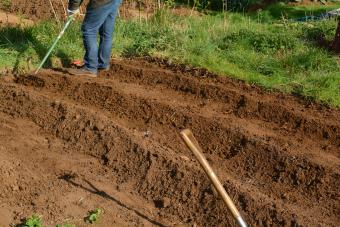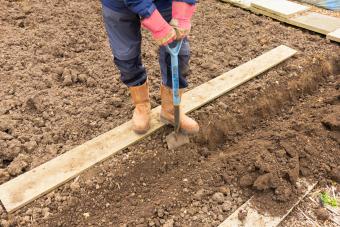How To Till Garden In Field
How to Till Soil Without a Tiller

You can learn how to till garden soil without needing a tiller. Hand tilling has several garden advantages over a motorized tiller. While labor intensive, you may find hand tilling is a better option for your vegetable garden and other types of gardens.
Raised Bed Tilling
If you decide to till raised beds, you'll work in squares instead of rows. Most raised bed gardeners don't till the soil since raised beds don't require it. However, there can be instances when tilling may be desired, such as a neglected and overgrown raised bed. In this case, you'll follow the instructions for hand tilling a row garden, only you'll work in squares instead of rows.
Gather Your Tools and Supplies
You need a few tools and possibly supplies. Before you set out to your garden, make sure you've gathered these and have what you need. These include, a shovel, a spade, digging fork, garden rake, wheelbarrow, and a good pair of work gloves to avoid blisters.
Organize Any Soil Amendments
Before you start hand tiling your garden, you want to organize any soil amendments you may need to use. This includes soil amendments, such as compost, much, peat, green sand, lime, etc. Determine if your soil needs amendments and which ones. Assess the condition of your soil by conducting several soil tests around your garden area along the length, width and center of your garden to get a complete picture of the soil conditions. If you plan to use fertilizer, add it, too.
Best Time to Hand Till Your Garden
The best time to hand till your garden is early spring. Plan to till just after the last frost of the spring. If possible, time your activity before new plant growth emerges or at the very least right when new plants began to break through the soil.

Determine Soil Readiness
You will need to work only under good soil conditions. If the soil is still slightly frozen, reschedule your digging. If there's been a week of rain and your garden is waterlogged, reschedule your digging. You want the soil to be workable and not muddy. Dig about 8" deep and grab a handful of soil, squeezing it into a ball and then breaking it up. If the soil falls apart easily, your soil is dry enough to hand till. If your soil is loose and has a loam makeup and isn't compacted, you have no reason to till your garden.
Step One: Start With a Good Mulch
You want to add about an inch of compost to your garden space and any soil amendments. Spread this material over the entire garden area before you begin digging. This will ensure the mulch gets mixed in with your soil to help break it up and provide needed nutrients.
Step Two: Start at One Corner of Garden
You want to start digging at one corner of the garden. You'll need to work the entire length of your plot by digging a row that's around 10" to 12" wide and 12" deep. The width and depth ensure you are covering the needed space for healthy plants to grow.
Step Three: Displace Soil
You'll pile the soil you remove on the upper side of the trench you're digging. When you reach the opposite end of your garden, you're going to step down another twelve inches to begin digging another trench (row). This time you'll place the soil from the second row into the first row. You want to start the second row directly underneath the first row, so all the ground is tilled.
Step Four: Continue Digging Rows
You will continue working in this pattern, digging up a row, placing the soil into the previous row, until you come to the last row. This row will be filled with the soil you removed from the first row. If you're working a large garden space, you may need to get a wheelbarrow to transfer the displaced soil to your last row.

Alternate Method of Double Digging in the Same Row
Another popular method of double digging doesn't require displacing an entire row of soil into another row. Instead, you'll work in blocks of soil and replace the soil within the same row.
- Deposit the first shovels of dirt required to reach the 12" depth onto the ground along the edge of the row.
- The next shovel loads of the soil dug out beside the first block are deposited directly into the first hole you dug out.
- You'll repeat this down the entire length of the row.
- When you reach the end of the row, you deposit the soil from the new row, the second one you start directly below the first one.
- When you reach the end of your second row, you'll fill in the last block with the soil from the first block you dug up.
- Repeat this process until you've hand tilled your garden space.
Tips for Hand Tilling Garden Soil
A few tips can help you with your hand tilling. Your garden will thrive with this type of tilling option.
- You don't necessarily need to hand till your entire garden space. You can opt to till only the area where you will plant seeds or place transplants.
- During the process of digging up dirt and depositing it into rows, you want to break up any chunks of dirt with your shovel, spade or rake.
- Any rocks or boulders you find should be removed from the growing area.
- Only hand till your garden once a season to avoid disturbing earthworms or losing soil nutrients.
- Hand tilled soil is denser than machine tilled and provides plant roots a better home.
- You can use a broad fork to further loosen the soil once you've dug a trench or block.
- Be sure to use your rake to remove any rocks and to level the soil prior to sowing seeds and transplanting plants.
- Don't add fertilizers until your crops begins to bloom. If using compost, you shouldn't need to add fertilizer.
This video demonstrate how to use a broad fork and only double dig the planting area:
Do You Have to Till Your Garden?
A growing trend is not to till gardens. The premise is you don't disturb the beneficial nutrients and earthworms living underground. It also conserves on fuel, equipment, water, and amendments. However, some gardeners complain about constantly fighting weeds, the easy spreading of fungi or diseases when using this gardening technique.
Easy Steps on How to Till Soil Without a Tiller
Tilling a garden without a tiller can be a labor-intensive process. This 19th century French technique can provide you with several growing benefits and save you the cost of a tiller and maintaining it. You may want to try double digging in a small garden to see if it's a method you can enjoy using.
© 2021 LoveToKnow Media. All rights reserved.
How To Till Garden In Field
Source: https://garden.lovetoknow.com/garden-basics/how-till-soil-without-tiller
Posted by: walkerbegaid.blogspot.com

0 Response to "How To Till Garden In Field"
Post a Comment